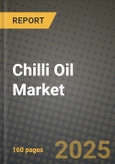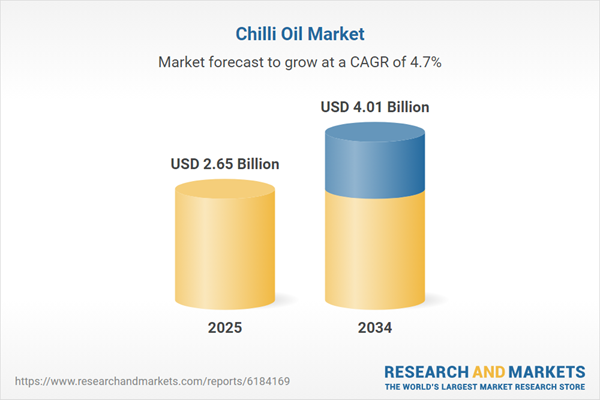Chilli Oil Market
The Chilli Oil market comprises infused and particulated oils made from chili peppers, aromatics, and carrier oils - ranging from premium cold-infused variants to heat-extracted, sediment-rich styles used as both condiment and cooking medium. Core end-uses span retail condiments, restaurant and QSR kitchens, meal kits and ready meals, dipping sauces, noodles and dumplings, pizza and fried chicken toppers, and gourmet snack coatings. Recent trends include artisanal small-batch SKUs with visible chili crisp particulates, clean-label and preservative-lean recipes, differentiated heat levels by cultivar, and chef-led collaborations that elevate regional authenticity (Sichuan, Hunan, Calabrian, Gochugaru, Mexican chiltepin). Drivers include the mainstreaming of Asian cuisines, social-media “spoon-over” culture, at-home entertaining, and private-label expansion that democratizes price points. The competitive landscape blends heritage Asian brands, Western specialty producers, private labels, and foodservice packers; differentiation hinges on chili varietal sourcing, oil quality (rapeseed, soybean, peanut, sesame, olive), aroma layering (garlic, scallion, star anise), particulate crunch stability, and low-off-note oxidation management. Execution priorities include managing supply volatility for chilies and aromatics, achieving shelf-stable clarity or suspended particulates without additive overload, ensuring consistent color and Scoville perception across lots, and packaging that prevents light and oxygen ingress while enabling appetizing visibility. Challenges persist around rancidity control, capsaicin handling and worker safety, potential allergen cross-contact (sesame/peanut), evolving retail clean-label guardrails, and keeping texture/crunch intact through hot-fill, retort, or e-commerce shipping conditions.Chilli Oil Market Key Insights
- Varietal sourcing and terroir drive signature flavor and heat. Brands win by curating chilies (Erjingtiao, Facing Heaven, Calabrian, ancho) to balance fruitiness, smoke, and numbing elements; blending dried and fresh profiles lifts aroma complexity. Long-term grower contracts and drying specs reduce color and potency drift season-to-season. Transparent origin stories, Scoville bands, and pairing cues help shoppers trade up without fear of “overheat.” Cold-chain for premium fresh chili preps safeguards volatile aromatics for flagship SKUs.
- Oil system design defines mouthfeel, color, and stability. Neutral oils showcase chili aromatics; sesame/peanut add depth but raise allergen governance. Antioxidant systems (rosemary extracts, tocopherols), low-oxygen processing, and light-barrier packaging curb rancidity and pigment fade. Particle size and fry curves govern crunch, sink/float behavior, and pourability. Filtration windows allow “clear” vs “crisp” positioning; de-aeration steps limit foaming and flavor loss in hot-fill.
- Texture leadership is a premiumization engine. Controlled Maillard on garlic/shallot chips, fried soy or peanut crumbles, and crispy chili flakes create audible crunch that photographs well and commands shelf premiums. Breading-like pre-treatments keep particulates crisp in oil, while moisture barriers prevent sogginess after opening. For foodservice, flowable “crisp-in-suspension” formats reduce nozzle clogs and speed line use in pizza, wings, and bowls.
- Clean-label and additive-light recipes are listing gatekeepers. Retailers scrutinize short ingredient decks, allergen clarity, and absence of synthetic colors. Heat-stable natural color retention relies on chili selection and gentle processing instead of dyes. Micro hurdles (aw, oil quality, spice sanitation) replace heavy preservatives. Country-specific sesame declarations and nut warning regimes demand harmonized labels to minimize relabel costs across markets.
- Safety, consistency, and capsaicin handling underpin scaling. Standardized fry temperatures and dwell times prevent acrylamide spikes and burnt notes. Air handling, PPE, and closed transfer mitigate worker exposure to aerosols. In-line color and viscosity checks, plus capsaicin assays, keep heat bands on target. Lot traceability for spices and aromatics, alongside environmental monitoring, reduces recall exposure and strengthens retailer confidence.
- Packaging is both protection and storytelling. Amber glass and multilayer barrier plastics slow oxidation; oxygen scavengers and nitrogen flush extend shelf life. Wide-mouth jars showcase particulates for “spoonability,” while squeeze bottles and drizzlers suit QSR and e-commerce. Easy-open and controlled-pour features cut mess and reinforce premium positioning. QR-linked recipes and heat guides improve engagement and repeat purchase.
- Foodservice and QSR partnerships shape velocity. Chain pizza, fried chicken, and noodle brands use chili oil for limited-time offers that drive trial and social buzz. Portion-control packs aid delivery and reduce back-of-house waste. Co-development on viscosity and cling ensures appealing sheen without pooling. Data sharing on attach rates helps optimize menu placement and bundling.
- Private label scales the middle of the market. Retailers replicate leading flavor cues with simpler decks and reliable crunch at accessible price points. Co-packers that offer guarded recipes, allergen segregation, and rapid sensory turnarounds secure multi-year awards. Tiered architectures (“classic,” “garlic crisp,” “extra hot,” “smoky”) prevent SKU bloat while covering shopper needs.
- Hybrid and dietary variants expand reach. Low-sodium, no-MSG, keto-friendly, and vegan cues widen baskets without diluting flavor. Garlic-free or nut-free lines serve sensitive consumers. Novelty plays - black garlic, citrus-zest oils, or fermented chili - create news cycles. For snacks, chili-oil dustings and drizzles on crackers and nuts build cross-category synergies.
- Internationalization requires regulatory and culinary fluency. Capsaicin limits, allergen lists, and additive rules vary by region; bilingual labels and regionally relevant heat scales smooth entry. Culinary localization (e.g., Calabrian-in-olive oil for Mediterranean, gochugaru-sesame for Korea-inspired) drives authenticity. Distributor education on rotation, storage, and demo tactics raises sell-through in modern trade.
Chilli Oil Market Reginal Analysis
North America
Consumer adoption rides the mainstreaming of Asian flavors and social-media-driven charcuterie and pizza toppings. Premium “chili crisp” styles dominate specialty and e-commerce, while private label pushes accessible heat and clean-label standards. Foodservice trials drive throughput in pizza, chicken, and bowl concepts. Packaging shifts to squeezable drizzlers for convenience, with amber barriers favored to prolong color and aroma.Europe
Demand concentrates in specialty retail, Mediterranean fusion, and premium pizzerias, with growth in private label for supermarkets. Provenance stories (Calabrian, Spanish ñora) resonate alongside Sichuan profiles. Retailers emphasize allergen governance, recyclable glass, and additive-light recipes. Foodservice requires consistent viscosity for drizzle aesthetics and heat-band reliability to satisfy diverse palates.Asia-Pacific
The category’s home turf spans mass-market pantry staples to chef-led artisanal jars. Regional differentiation is strong: Sichuan and Hunan heat, Japanese rayu, Korean gochugaru-sesame variants. Foodservice packs and industrial formats supply noodles, dumplings, and snack coatings. Innovation focuses on texture stability in hot climates and e-commerce-ready packaging that resists leakage and oxidation.Middle East & Africa
Urban hubs show rising interest via modern trade, premium dining, and delivery platforms. Chili oil complements mezze and grilled meats; halal-aligned labels and sesame transparency are essential. Heat and light exposure during distribution push demand for barrier packaging and antioxidants. Distributors favor robust shelf-life data and training on handling to reduce returns.South & Central America
Growth stems from fusion cuisine, pizza and wings, and specialty retail. Local chili traditions (ají, malagueta) inform flavor innovation. Supply chains prioritize cost-effective oils and locally sourced aromatics to manage currency swings. Packaging must handle warm logistics; vacuum seals and tamper-evident closures build trust for emerging brands and private labels.Chilli Oil Market Segmentation
By Type
- Hot Pressed
- Cold Pressed
By Application
- Home Use
- Restaurant
By Process
- Processed with Oil
- Processed with Water
By Distribution Channel
- Online
- Offline
Key Market players
Lao Gan Ma, Fly By Jing, S&B Foods, Chiu-Chow Style Hot-Chili Oil (Pearl River Bridge), Lee Kum Kee, Yeo’s, Momofuku, CY Eats, Junzi Kitchen, You Po Lazi, Xi’an Famous Foods Chili Oil, Me’s Way, TITAN Foods (Sichuan Chili Oil), Don Chilio, Maille (Infused Chili Oil)Chilli Oil Market Analytics
The report employs rigorous tools, including Porter’s Five Forces, value chain mapping, and scenario-based modelling, to assess supply-demand dynamics. Cross-sector influences from parent, derived, and substitute markets are evaluated to identify risks and opportunities. Trade and pricing analytics provide an up-to-date view of international flows, including leading exporters, importers, and regional price trends.Macroeconomic indicators, policy frameworks such as carbon pricing and energy security strategies, and evolving consumer behaviour are considered in forecasting scenarios. Recent deal flows, partnerships, and technology innovations are incorporated to assess their impact on future market performance.
Chilli Oil Market Competitive Intelligence
The competitive landscape is mapped through proprietary frameworks, profiling leading companies with details on business models, product portfolios, financial performance, and strategic initiatives. Key developments such as mergers & acquisitions, technology collaborations, investment inflows, and regional expansions are analyzed for their competitive impact. The report also identifies emerging players and innovative startups contributing to market disruption.Regional insights highlight the most promising investment destinations, regulatory landscapes, and evolving partnerships across energy and industrial corridors.
Countries Covered
- North America - Chilli Oil market data and outlook to 2034
- United States
- Canada
- Mexico
- Europe - Chilli Oil market data and outlook to 2034
- Germany
- United Kingdom
- France
- Italy
- Spain
- BeNeLux
- Russia
- Sweden
- Asia-Pacific - Chilli Oil market data and outlook to 2034
- China
- Japan
- India
- South Korea
- Australia
- Indonesia
- Malaysia
- Vietnam
- Middle East and Africa - Chilli Oil market data and outlook to 2034
- Saudi Arabia
- South Africa
- Iran
- UAE
- Egypt
- South and Central America - Chilli Oil market data and outlook to 2034
- Brazil
- Argentina
- Chile
- Peru
Research Methodology
This study combines primary inputs from industry experts across the Chilli Oil value chain with secondary data from associations, government publications, trade databases, and company disclosures. Proprietary modeling techniques, including data triangulation, statistical correlation, and scenario planning, are applied to deliver reliable market sizing and forecasting.Key Questions Addressed
- What is the current and forecast market size of the Chilli Oil industry at global, regional, and country levels?
- Which types, applications, and technologies present the highest growth potential?
- How are supply chains adapting to geopolitical and economic shocks?
- What role do policy frameworks, trade flows, and sustainability targets play in shaping demand?
- Who are the leading players, and how are their strategies evolving in the face of global uncertainty?
- Which regional “hotspots” and customer segments will outpace the market, and what go-to-market and partnership models best support entry and expansion?
- Where are the most investable opportunities - across technology roadmaps, sustainability-linked innovation, and M&A - and what is the best segment to invest over the next 3-5 years?
Your Key Takeaways from the Chilli Oil Market Report
- Global Chilli Oil market size and growth projections (CAGR), 2024-2034
- Impact of Russia-Ukraine, Israel-Palestine, and Hamas conflicts on Chilli Oil trade, costs, and supply chains
- Chilli Oil market size, share, and outlook across 5 regions and 27 countries, 2023-2034
- Chilli Oil market size, CAGR, and market share of key products, applications, and end-user verticals, 2023-2034
- Short- and long-term Chilli Oil market trends, drivers, restraints, and opportunities
- Porter’s Five Forces analysis, technological developments, and Chilli Oil supply chain analysis
- Chilli Oil trade analysis, Chilli Oil market price analysis, and Chilli Oil supply/demand dynamics
- Profiles of 5 leading companies - overview, key strategies, financials, and products
- Latest Chilli Oil market news and developments
Additional Support
With the purchase of this report, you will receive:- An updated PDF report and an MS Excel data workbook containing all market tables and figures for easy analysis.
- 7-day post-sale analyst support for clarifications and in-scope supplementary data, ensuring the deliverable aligns precisely with your requirements.
- Complimentary report update to incorporate the latest available data and the impact of recent market developments.
This product will be delivered within 1-3 business days.
Table of Contents
Companies Mentioned
- Lao Gan Ma
- Fly By Jing
- S&B Foods
- Chiu-Chow Style Hot-Chili Oil (Pearl River Bridge)
- Lee Kum Kee
- Yeo’s
- Momofuku
- CY Eats
- Junzi Kitchen
- You Po Lazi
- Xi’an Famous Foods Chili Oil
- Me’s Way
- TITAN Foods (Sichuan Chili Oil)
- Don Chilio
- Maille (Infused Chili Oil)
Table Information
| Report Attribute | Details |
|---|---|
| No. of Pages | 160 |
| Published | November 2025 |
| Forecast Period | 2025 - 2034 |
| Estimated Market Value ( USD | $ 2.65 Billion |
| Forecasted Market Value ( USD | $ 4.01 Billion |
| Compound Annual Growth Rate | 4.7% |
| Regions Covered | Global |
| No. of Companies Mentioned | 15 |









